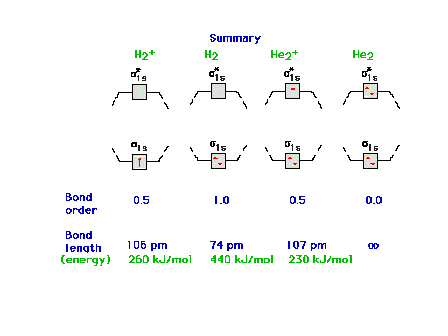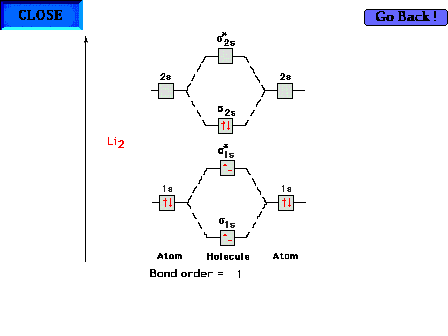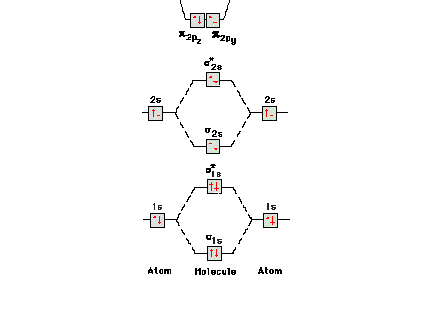| Lecture #20 |
| Text: Chapter 14 Section 3 |
| CURMUDGEON
GENERAL'S WARNING. These "slides"
represent highlights from lecture and are neither
complete nor meant to replace lecture. It is
advised not to use
these as a reliable means to replace missed
lecture material. Do so at risk to healthy
academic performance in 09-105. |
|
| Lecture Outline |
Quantum Theory of the Chemical Bond
Molecular orbitals (in "homonuclear diatomic
molecules")
Molecular energy level diagrams
Building up electron configurations
Bond order
|
| Re-defining how one calculates bond order within the
context of molecular orbital theory. |
 |
The molecular orbital energy diagram for H2-
and other isoelectronic species, all having bond order =
0.5. The electron configuration would be written as s1s2 s*1s2
s2s2
or, as in the current text, simply ss2 s*s2
ss2. |
 |
| Molecular orbital energy diagrams for 1, 2, 3, and 4
electrons systems. The correspondence between bond order
and bondlength and between bond order and bond energy is
shown for each molecular species. |
 |
| The molecular orbital energy diagram for Li2
containing all six electrons. Since antibonding electrons
negate the effect of bonding electrons, the pair of s* electrons cancels out
the bonding characteristics of the pair of s electrons and both pairs revert to
the inner core 1s2 configurations that we
expect from simpler considerations. The electron
configuration could thus be written as [He][He]s2s2. |
 |
| The molecular orbital energy diagram for Be2.
Since the number of antibonding electrons is equal to the
number of bonding electrons, there is no net bonding in
this molecule and it simply breaks back up into two Be
atoms. |
 |
| For "diboron", B2 we get a
somewhat surprising result out of the molecular orbital
energy diagram and the ensuing electron configuration.
The ninth and tenth electrons go into the lowest energy
available orbitals. These are the p orbitals. There are two of equal
energy and Hund's rule forces us to put one electron in
each and with parallel spins. Thus we have bond order =
1, a single bond, but it is not a sigma bond. In fact,
there is one electron in one pi-orbital and another
electron in a second pi-orbital comprising this single
bond. |
 |
| Molecular orbital energy diagram for the lower states
in molecular nitrogen, N2. The lowest two
molecular orbitals return to 1s, inner core electrons on
each nitrogen atom. The next two pairs, with no net
bonding effect, become lone pairs that can be pictured as
being in 2s valence orbitals on each nitrogen. |
 |
| The valence molecular orbitals in nitrogen that give
rise to the triple bond, bond order = 3. |
 |

Click the Detour sign to see an optional explanation
(several slides) of why the p/s
sequence changes when O2 and F2 are
reached. Note, you do not need to
remember this reversal of sequence. For your convenience
in 09-105, you can ignore it even if it seems to apply. |
 |
| The electron configuration for all 14 electrons in N2.
Three variations are shown on how to represent the inner
core, 1s2 electrons on each nitrogen atom.
Sometimes the two pi molecular orbitals are respresented
with a single p4
symbol. |
 |
| Comparison of ionization energies for atomic N and
molecular N2 to illustrate that the bonding
molecular orbital in the latter is more stable than the
atomic orbital from which it "originates". That
is, combining two N atoms leads to a more stable, bound
nitrogen molecule, releasing energy. |
 |
| The highest occupied molecular orbitals in molecular
oxygen. The bond order is 2, but is composed of a sigma
bond and one net electron in each of the two p orbitals. The molecule is
paramagnetic due to the two parallel electron spins. |
 |
| Comparison of ionization energies for atomic O and
molecular O2 to illustrate that the
antibonding molecular orbital in the latter is less
stable than the atomic orbital from which it
"originates". That is, electrons in the
antibonding orbitals "want" to release energy
by returning to atomic orbitals. |
 |
| The trend in bonding characteristics in going across
the top row of the periodic table looking at homonuclear
diatomic molecules from B2 through F2.
The bond characteristics -- bondlength and bond energy --
track bond order in the manner expected. |
 |